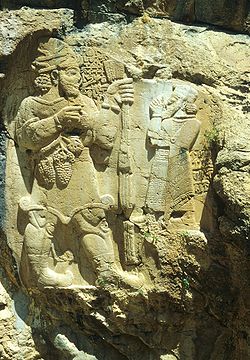
Warpalawas
Encyclopedia

Warpalawa was a late 8th century BC (ca 730-710 BC?) Late Hittite (or Neo-Hittite
Neo-Hittite
The states that are called Neo-Hittite, or more recently Syro-Hittite, were Luwian, Aramaic and Phoenician-speaking political entities of the Iron Age northern Syria and southern Anatolia that arose following the collapse of the Hittite Empire around 1180 BC and lasted until roughly 700 BC...
) king of Tabal
Tabal
Tabal was a Luwian speaking Neo-Hittite kingdom of South Central Anatolia. According to archaeologist Kurt Bittel, the kingdom of Tabal first appeared after the collapse of the Hittite Empire....
in south-central Anatolia
Anatolia
Anatolia is a geographic and historical term denoting the westernmost protrusion of Asia, comprising the majority of the Republic of Turkey...
(modern Turkey
Turkey
Turkey , known officially as the Republic of Turkey , is a Eurasian country located in Western Asia and in East Thrace in Southeastern Europe...
). The political center of this Early Iron Age
Iron Age
The Iron Age is the archaeological period generally occurring after the Bronze Age, marked by the prevalent use of iron. The early period of the age is characterized by the widespread use of iron or steel. The adoption of such material coincided with other changes in society, including differing...
regional state was probably Tuwanuwa (or Tuwana or Tuhana/ later Roman Tyana
Tyana
Tyana or Tyanna was an ancient city in the Anatolian region of Cappadocia, in modern south-central Turkey. It was the capital of a Luwian-speaking Neo-Hittite kingdom in the 1st millennium BC.-History:...
).
Among other commemorative monuments, Warpalawas most notably commissioned the carving of a rock-relief at the site of Ivriz
Ivriz
Ivriz is an Iron Age archaeological site of a Neo-Hittite rock-relief monument and cult place in south-central Anatolia . The rock relief depicts the late 8th c...
near a spring, south of Tuwanuwa in the province of Konya
Konya
Konya is a city in the Central Anatolia Region of Turkey. The metropolitan area in the entire Konya Province had a population of 1,036,027 as of 2010, making the city seventh most populous in Turkey.-Etymology:...
. In the relief, he is depicted with the storm-god Tarhunzas. His attire in the relief is seen as an evidence for his kingdom's close affinity with the Phrygians. The relief is accompanied with a hieroglyphic Luwian
Hieroglyphic Luwian
Hieroglyphic Luwian is a variant of the Luwian language, recorded in official and royal seals and a small number of monumental inscriptions. It is written in a hieroglyphic script known as Anatolian hieroglyphs...
inscription. The Tabalian king Urballa, mentioned in the Assyria
Assyria
Assyria was a Semitic Akkadian kingdom, extant as a nation state from the mid–23rd century BC to 608 BC centred on the Upper Tigris river, in northern Mesopotamia , that came to rule regional empires a number of times through history. It was named for its original capital, the ancient city of Assur...
n texts at the time of Tiglath-pileser III
Tiglath-Pileser III
Tiglath-Pileser III was a prominent king of Assyria in the eighth century BC and is widely regarded as the founder of the Neo-Assyrian Empire. Tiglath-Pileser III seized the Assyrian throne during a civil war and killed the royal family...
and Sargon II
Sargon II
Sargon II was an Assyrian king. Sargon II became co-regent with Shalmaneser V in 722 BC, and became the sole ruler of the kingdom of Assyria in 722 BC after the death of Shalmaneser V. It is not clear whether he was the son of Tiglath-Pileser III or a usurper unrelated to the royal family...
probably is Warpalawas.

